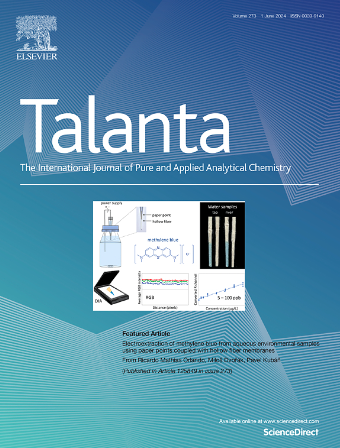Advances in quantum dot-based fluorescence sensors for environmental and biomedical detection
IF 5.6
1区 化学
Q1 CHEMISTRY, ANALYTICAL
引用次数: 0
Abstract
This review explores the evolution and application of fluorescence sensors based on quantum dots (QDs) for detecting environmental and biological analytes across diverse real-world scenarios and complex sample matrices and also categorizes different types of quantum dots, such as carbon dots (C-dots), graphene quantum dots (GQDs), and metal-doped QDs and examines their properties, including tunable fluorescence, low toxicity, and photostability, which make them ideal for a variety of applications. Key sensing mechanisms, including Förster Resonance Energy Transfer (FRET) and fluorescence quenching, are discussed alongside innovations like paper-based, ratiometric, and turn-on/turn-off sensors. Additionally, case studies are provided to showcase the application of these sensors in environmental and biomedical fields, where they provide rapid, sensitive, and cost-effective solutions. This review presents the potential of quantum dot-based fluorescence sensors to transform analytical detection technologies, offering new opportunities in environmental monitoring, bioimaging, and public health safety.

用于环境和生物医学检测的量子点荧光传感器的研究进展
本文探讨了基于量子点(QDs)的荧光传感器在不同现实场景和复杂样品基质中检测环境和生物分析物的发展和应用,并对不同类型的量子点进行了分类,如碳点(C-dots)、石墨烯量子点(GQDs)和金属掺杂量子点,并研究了它们的特性,包括可调谐荧光、低毒性和光稳定性。这使它们成为各种应用的理想选择。关键的传感机制,包括Förster共振能量转移(FRET)和荧光猝灭,以及创新,如基于纸张,比例和开关传感器进行了讨论。此外,还提供了案例研究,以展示这些传感器在环境和生物医学领域的应用,在这些领域,它们提供了快速、敏感和具有成本效益的解决方案。本文综述了基于量子点的荧光传感器在改变分析检测技术方面的潜力,为环境监测、生物成像和公共卫生安全提供了新的机会。
本文章由计算机程序翻译,如有差异,请以英文原文为准。
求助全文
约1分钟内获得全文
求助全文
来源期刊

Talanta
化学-分析化学
CiteScore
12.30
自引率
4.90%
发文量
861
审稿时长
29 days
期刊介绍:
Talanta provides a forum for the publication of original research papers, short communications, and critical reviews in all branches of pure and applied analytical chemistry. Papers are evaluated based on established guidelines, including the fundamental nature of the study, scientific novelty, substantial improvement or advantage over existing technology or methods, and demonstrated analytical applicability. Original research papers on fundamental studies, and on novel sensor and instrumentation developments, are encouraged. Novel or improved applications in areas such as clinical and biological chemistry, environmental analysis, geochemistry, materials science and engineering, and analytical platforms for omics development are welcome.
Analytical performance of methods should be determined, including interference and matrix effects, and methods should be validated by comparison with a standard method, or analysis of a certified reference material. Simple spiking recoveries may not be sufficient. The developed method should especially comprise information on selectivity, sensitivity, detection limits, accuracy, and reliability. However, applying official validation or robustness studies to a routine method or technique does not necessarily constitute novelty. Proper statistical treatment of the data should be provided. Relevant literature should be cited, including related publications by the authors, and authors should discuss how their proposed methodology compares with previously reported methods.
 求助内容:
求助内容: 应助结果提醒方式:
应助结果提醒方式:


